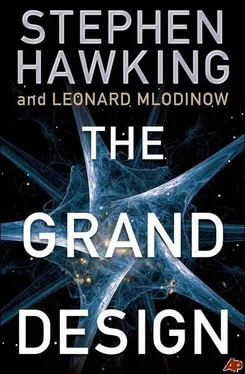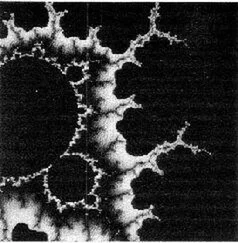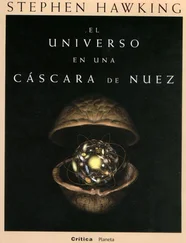At the time that scientific determinism was first proposed, Newton ’s laws of motion and gravity were the only laws known. We have described how these laws were extended by Einstein in his general theory of relativity, and how other laws were discovered to govern other aspects of the universe.
The laws of nature tell us how the universe behaves, but they don’t answer the why? questions that we posed at the start of this book:
Why is there something rather than nothing?
Why do we exist?
Why this particular set of laws and not some other?
Some would claim the answer to these questions is that there is a God who chose to create the universe that way. It is reasonable to ask who or what created the universe, but if the answer is God, then the question has merely been deflected to that of who created God. In this view it is accepted that some entity exists that needs no creator, and that entity is called God. This is known as the first-cause argument for the existence of God. We claim, however, that it is possible to answer these questions purely within the realm of science, and without invoking any divine beings.
According to the idea of model-dependent realism introduced in Chapter 3, our brains interpret the input from our sensory organs by making a model of the outside world. We form mental concepts of our home, trees, other people, the electricity that flows from wall sockets, atoms, molecules, and other universes. These mental concepts are the only reality we can know. There is no model-independent test of reality. It follows that a well-constructed model creates a reality of its own. An example that can help us think about issues of reality and creation is the Game of Life, invented in 1970 by a young mathematician at Cambridge named John Conway.
The word “game” in the Game of Life is a misleading term. There are no winners and losers; in fact, there are no players. The Game of Life is not really a game but a set of laws that govern a two-dimensional universe. It is a deterministic universe: Once you set up a starting configuration, or initial condition, the laws determine what happens in the future.
The world Conway envisioned is a square array, like a chessboard, but extending infinitely in all directions. Each square can be in one of two states: alive (shown in green) or dead (shown in black). Each square has eight neighbors: the up, down, left, and right neighbors and four diagonal neighbors. Time in this world is not continuous but moves forward in discrete steps. Given any arrangement of dead and live squares, the number of live neighbors determine what happens next according to the following laws:
1. A live square with two or three live neighbors survives (survival).
2. A dead square with exactly three live neighbors becomes a live cell (birth).
3. In all other cases a cell dies or remains dead. In the case that a live square has zero or one neighbor, it is said to die of loneliness; if it has more than three neighbors, it is said to die of overcrowding.
That’s all there is to it: Given any initial condition, these laws generate generation after generation. An isolated living square or two adjacent live squares die in the next generation because they don’t have enough neighbors. Three live squares along a diagonal live a bit longer. After the first time step the end squares die, leaving just the middle square, which dies in the following generation. Any diagonal line of squares “evaporates” in just this manner. But if three live squares are placed horizontally in a row, again the center has two neighbors and survives while the two end squares die, but in this case the cells just above and below the center cell experience a birth. The row therefore turns into a column. Similarly, the next generation the column back turns into a row, and so forth. Such oscillating configurations are called blinkers.

If three live squares are placed in the shape of an L, a new behavior occurs. In the next generation the square cradled by the L will give birth, leading to a 2 × 2 block. The block belongs to a pattern type called the still life because it will pass from generation to generation unaltered. Many types of patterns exist that morph in the early generations but soon turn into a still life, or die, or return to their original form and then repeat the process.
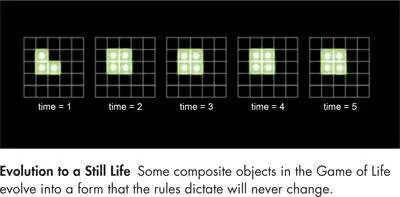
There are also patterns called gliders, which morph into other shapes and, after a few generations, return to their original form, but in a position one square down along the diagonal. If you watch these develop over time, they appear to crawl along the array. When these gliders collide, curious behaviors can occur, depending on each glider’s shape at the moment of collision.
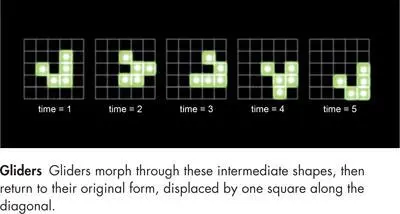
What makes this universe interesting is that although the fundamental “physics” of this universe is simple, the “chemistry” can be complicated. That is, composite objects exist on different scales. At the smallest scale, the fundamental physics tells us that there are just live and dead squares. On a larger scale, there are gliders, blinkers, and still-life blocks. At a still larger scale there are even more complex objects, such as glider guns: stationary patterns that periodically give birth to new gliders that leave the nest and stream down the diagonal.
If you observed the Game of Life universe for a while on any particular scale, you could deduce laws governing the objects on that scale. For example, on the scale of objects just a few squares across you might have laws such as “Blocks never move,” “Gliders move diagonally,” and various laws for what happens when objects collide. You could create an entire physics on any level of composite objects. The laws would entail entities and concepts that have no place among the original laws. For example, there are no concepts such as “collide” or “move” in the original laws. Those describe merely the life and death of individual stationary squares. As in our universe, in the Game of Life your reality depends on the model you employ.
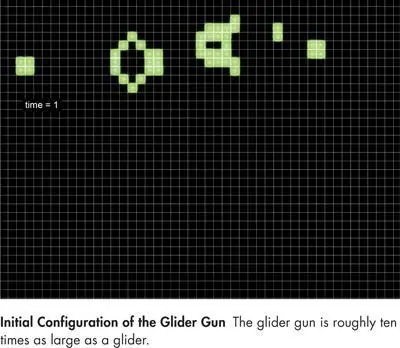
Conway and his students created this world because they wanted to know if a universe with fundamental rules as simple as the ones they defined could contain objects complex enough to replicate. In the Game of Life world, do composite objects exist that, after merely following the laws of that world for some generations, will spawn others of their kind? Not only were Conway and his students able to demonstrate that this is possible, but they even showed that such an object would be, in a sense, intelligent! What do we mean by that? To be precise, they showed that the huge conglomerations of squares that self-replicate are “universal Turing machines.” For our purposes that means that for any calculation a computer in our physical world can in principle carry out, if the machine were fed the appropriate input-that is, supplied the appropriate Game of Life world environment-then some generations later the machine would be in a state from which an output could be read that would correspond to the result of that computer calculation.
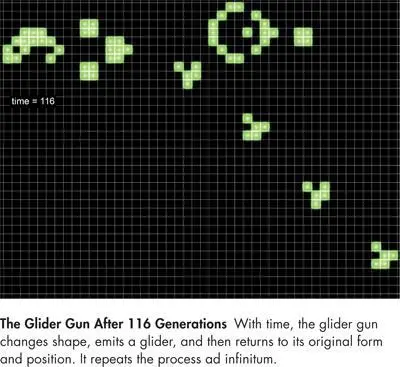
To get a taste for how that works, consider what happens when gliders are shot at a simple 2 × 2 block of live squares. If the gliders approach in just the right way, the block, which had been stationary, will move toward or away from the source of the gliders. In this way, the block can simulate a computer memory. In fact, all the basic functions of a modern computer, such as AND and OR gates, can also be created from gliders. In this manner, just as electrical signals are employed in a physical computer, streams of gliders can be employed to send and process information.
Читать дальше
